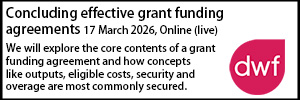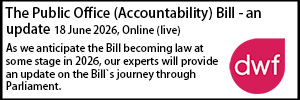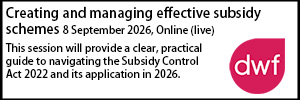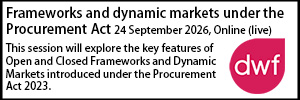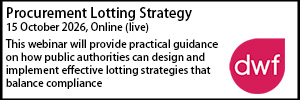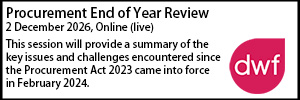Procurement Bill: Competitive flexible procedure
- Details
How will the competitive flexible procedure work in practice? Michael Mousdale explains.
Royal assent now looms as the Procurement Bill is in the later stages of the Parliamentary process. In preparation for the reforms, this article zooms in on one of the new procurement procedures introduced by the Bill, namely, the competitive flexible procedure.
The competitive flexible procedure is one of two new competitive tendering procedures proposed under the Bill, which must be adopted before the award of a public contract. The first procedure, the ‘open procedure’, will be familiar to contracting authorities and is a single stage procedure where an interested party can submit a tender in response to an advertised public contract. Whereas the second, the ‘competitive flexible procedure’, is described as “any other” competitive tendering procedure which a contracting authority deems appropriate for the purpose of awarding the public contract.
The two new competitive tendering procedures introduced by the Bill represent a reduction from the eight identifiable procurement procedures which feature across different current regimes, including the Public Contract Regulations 2015, the Utilities Contracts Regulations 2016 and the Concessions Contracts Regulations 2016. In turn, this echoes the aim of simplification under the Bill.
What are the main features of the competitive flexible procedure?
Flexibility
The clue is in the title - flexibility is the key feature of this new procedure. The Bill takes a permissive approach to describe the features of the competitive flexible procedure, noting that such a procedure may be a multi-stage process where supplier participants are limited in each of the stages, and where the award criteria may be refined at each successive stage.
The competitive flexible procedure, as the name suggests, invites flexibility to allow contracting authorities to design the procurement process according to considerations specific to the particular contract being procured. This should allow the public sector to really consider the market it is seeking bids from and its own requirements when shaping each procurement process.
In designing the procedure, the contracting authority must be mindful of the overriding requirement of proportionality - it should ensure that the process it designs is not unnecessarily complex or burdensome for suppliers to comply with, by reference to the nature, complexity and cost of the contract requirement. Flexible does not necessarily mean complex. Where it is expected that SMEs are likely to bid for the contract, then this obligation to avoid undue complexity is even stronger, because of parallel obligations to have regard to the fact that SMEs may face particular barriers to participation.
Apart from this obligation to not make the procurement unduly complex, there is little more said in the Bill about how it should be done. It does specifically note that the authority might follow successive stages, in similar way to that afforded currently in competitive dialogue or competitive procedure with negotiation.
One can easily draw parallels between the competitive flexible procedure and the light touch regime (LTR) under the current PCR. The LTR is only applicable to health, social, education and certain other services. Like the competitive flexible procedure, it gives authorities the flexibility in how they choose to run a procurement process, subject to compliance with the overriding principles of transparency, equal treatment and non-discrimination. Any experience that contracting authorities have in running LTR processes will be really helpful in understanding the competitive flexible procedure and may be a good starting point for its adoption. However, whereas the LTR provides the option to simply adopt one of the existing procedures (such as competitive dialogue), that “get-out” option is not applicable in the new regime, where such alternatives do not exist.
Principles / objectives
What will be obvious from examination of the procedure is that it is light on detailed rules. That is the whole point, which was to empower the contracting authority to take decisions for themselves about what works best for them for any given procurement need. However, there are still limits to the flexibility the Bill aims to introduce. Contracting authorities following this process will be subject to the provisions of the Bill, including the procurement principles and objectives. In the Explanatory Notes to the Bill, the government made this clear: “Implicitly this will operate within the bounds of the provisions of the Bill (such as procurement principles, publication and other requirement applicable to a competitive procedure) but can be designed around what would work best for the specific procurement”.
The permissive nature of the competitive flexible procedure and the absence of detailed rules on its use, mean that public authorities should pay special attention to ensure that any bespoke process is in-line with these procurement principles (a further briefing on the principles and objectives in the Procurement Bill will be released as part of this series). Procurement professionals will be very familiar with the concepts of equal treatment and making sure that an unfair advantage is not given to one supplier over another. In building a process under this procedure these overriding principles must still be observed.
Contracting authorities should also be mindful of the National Procurement Policy Statement (this is a statement that may be published by a minister setting out the government’s strategic priorities in relation to procurement) and the impact this may have in designing its procurement process.
Tender notices
Notwithstanding the apparent simplification, two options are given for the provision of tender notices and associated documents under the competitive flexible procedure:
- suppliers may be invited to submit a request to participate in the procedure; or
- simply invited to submit their first, or only, tender as part of the procedure.
This seems to imply that in following the second option, the contracting authority is purposely limiting its flexibility. This has some similarities to the current competitive procedure with negotiation where the authority can reserve the right to award after the submission of initial tenders without the need for any negotiation. Another way of looking at it is that if the authority was looking to carry out an open procedure, but wanted to reserve the right to negotiate after submission of tenders, this would be a mechanism to give that flexibility, without it having to embark down the route of a full competitive flexible procedure.
Refinement of award criteria
Under the competitive flexible procedure, where the authority intends to include successive stages, it is permissible to refine the award criteria at each stage, provided this right is reserved in the tender notice and associated documents. Perhaps somewhat obviously, the refinement cannot take place once tenders have been submitted. The refinement can be in relation to the selection criteria or the relative importance (weighting) of the criteria, but cannot have the effect of altering any earlier assessment against such criteria. It is also necessary to republish the tender notice and associated documents affected by refinements. We cannot conceive that this means that the procedure must start again, but merely that the record is corrected as such.
What can the public sector do to prepare for the use of the competitive flexible procedure?
1. Understand the new procedure
Understand the extent of the flexibility you have and how you might apply it in complex and more straightforward procurements.
It may be sensible not to focus on the term “competitive flexible procedure” as this might suggest a single set way of doing things. Instead focus on the wording in the Act: “such other competitive tendering procedure as the contracting authority considers appropriate for the purpose of awarding the public contract”.
2. Flexibility is a double-edged sword
Though the competitive flexible procedure allows for the design of a procurement process tailored around the specific public contract at hand, lack of clear rules warrants more emphasis on clarity in documenting the proposed process to avoid obscurity for the parties involved.
The very clear proportionality requirements will mean that the authority cannot slavishly follow a set way of doing competitive flexible, however much thought they have given in the first instance to this new-found freedom. This means ensuring that any template procurement documents which are developed are updated on a case by case basis to reflect the process designed for a specific procurement process. Internal guidance notes and standing orders should also be updated to reflect these new processes.
3. Review your procurement pipeline
Plan out in advance where your procurement process will benefit from the flexibility afforded by the competitive flexible procedure. This could be with regard to timescales, the number of participants to involve, setting evaluation criteria at different stages, and undertaking negotiations.
We will shortly be sharing a podcast on the practical considerations of the competitive flexible procedure, talking about how in practice we see this being used, the benefits for public authorities and potential pitfalls.
Michael Mousdale is a partner at Browne Jacobson.
Sponsored articles
Unlocking legal talent
Walker Morris supports Tower Hamlets Council in first known Remediation Contribution Order application issued by local authority
Lawyer (Planning and Regulatory)
Principal Lawyer - Planning, Property & Contract
Senior Lawyer - Planning, Property & Contracts Team
Legal Director - Government and Public Sector
Contracts Lawyer
Locums
Poll
15-07-2026 11:00 am


























